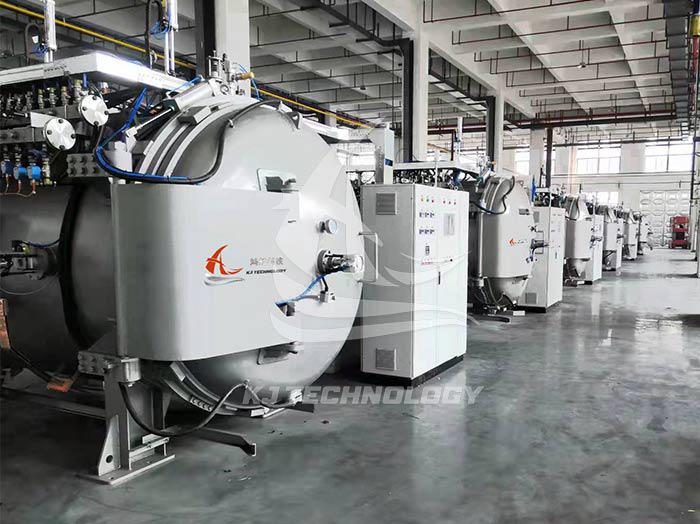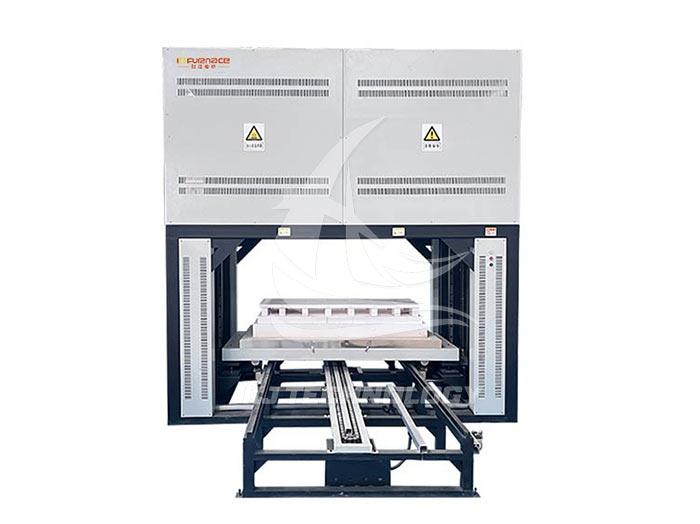Can industrial large-scale vacuum furnaces be annealed?
 11-14-2025 Author: KJ technology
11-14-2025 Author: KJ technology
Industrial large-scale vacuum furnaces can be fully used for annealing processes and have significant advantages in controlling material properties, avoiding oxidation pollution, and achieving complex processes. The following analysis will be conducted from four aspects: technical principles, process advantages, application scenarios, and operational points:
1. Technical principle: Annealing under vacuum environment
The annealing process of a vacuum electric furnace is completed through the following steps:
Vacuum loading: Place the workpiece in a vacuum furnace, evacuate to the target vacuum degree (usually ≤ 10 ⁻ ² Pa), isolate oxygen from other gases, and avoid oxidation reactions.
Heating stage: The material is slowly heated to the annealing temperature (such as the recrystallization temperature of steel or the transition temperature of glass) through resistance heating, induction heating, or electron beam heating.
Insulation stage: Maintain a certain amount of time at the target temperature to homogenize the internal structure of the material, eliminate internal stress, or improve plasticity.
Cooling stage: Select cooling method according to process requirements:
Slow cooling: Cool to room temperature with the furnace, suitable for materials that require reducing hardness and improving toughness (such as spring steel and high carbon steel).
Controlled cooling: Cooling at a specific rate (such as 10-50 ℃ per minute) to control the phase transformation process and obtain specific structures (such as pearlite and bainite).
Fast cooling: Inject inert gases (such as nitrogen and argon) to accelerate cooling and shorten production cycles (applicable to some amorphous alloys or special materials).
Key point: The vacuum environment completely isolates oxygen, avoiding surface oxidation or decarburization of the workpiece, while achieving precise control of material properties through precise temperature control and cooling rate.
2. Process advantage: The core value of vacuum annealing
No oxidation, no pollution
In traditional atmospheric annealing, the surface of the workpiece is prone to react with oxygen to form oxide scale, resulting in increased surface roughness and decreased dimensional accuracy. Vacuum annealing completely avoids this problem, with high surface smoothness and no need for subsequent polishing or acid washing treatment.
Case: A precision bearing factory uses vacuum annealing to treat GCr15 steel bearing rings, reducing the thickness of the surface oxide layer and improving the accuracy of dimensional tolerance control.
Significant degassing effect
Vacuum environment can remove gases such as hydrogen and nitrogen inside materials, reduce the risk of hydrogen embrittlement, and improve material toughness and fatigue life. For example, after vacuum annealing, the fatigue crack propagation resistance of aviation aluminum alloy is improved.
Excellent organizational uniformity
During the vacuum heating and cooling process, the temperature distribution is more uniform to avoid uneven organization caused by local overheating or undercooling. For example, after vacuum annealing of stainless steel, the grain size uniformity error is ≤ level 1 (according to ASTM standards), which is significantly better than atmospheric annealing.
High process flexibility
A composite heat treatment process can be formed by combining other processes such as vacuum quenching and vacuum tempering to meet complex performance requirements. For example, mold steel is first vacuum annealed to eliminate internal stress, then vacuum quenched to increase hardness, and finally vacuum tempered to adjust toughness.
3. Application scenario: Typical industry of vacuum annealing
aerospace
Used for annealing high-temperature alloys (such as Inconel 718) and titanium alloys (such as Ti-6Al-4V), eliminating work hardening, improving material plasticity, and facilitating subsequent forming or machining. For example, the elongation of a certain type of aircraft engine blade increases after vacuum annealing.
automotive industry
Process spring steel (such as 55CrMnA) and gear steel (such as 20CrMnTi), eliminate quenching stress, restore toughness, and prevent fracture during use. For example, after vacuum annealing, the fatigue life of car suspension springs is improved.
Electronic Semiconductor
Annealing magnetic materials (such as neodymium iron boron) and precision ceramics to improve their magnetic properties or mechanical strength. For example, after vacuum annealing of neodymium iron boron permanent magnets, the remanence Br increases and the coercivity Hcj increases.
medical device
Process stainless steel (such as 316L) and cobalt chromium alloy (such as Co Cr Mo) implants to eliminate internal stress and improve biocompatibility. For example, after vacuum annealing of artificial joints, the surface roughness Ra is ≤ 0.1 μ m, reducing the risk of wear and inflammation.
precision mold
Annealing of mold steel (such as H13, S7) to reduce hardness for cutting, while reserving space for subsequent quenching and tempering to adjust the microstructure. For example, after vacuum annealing of plastic molds, the cutting efficiency is improved and the mold life is extended.
4. Key points of operation: Process control of vacuum annealing
Vacuum degree selection
The general annealing process requires a vacuum degree of ≤ 10 ⁻ ² Pa, and high-precision parts (such as optical molds) require ≤ 10 ⁻ ³ Pa to completely eliminate the risk of oxidation. For materials containing volatile elements such as magnesium and zinc, a higher vacuum degree (≤ 10 ⁻⁴ Pa) is required.
temperature control
The annealing temperature needs to be precisely set according to the material composition and performance requirements. For example:
The vacuum annealing temperature for spring steel 55CrMnA is 680-720 ℃, with a temperature deviation within ± 5 ℃;
The vacuum annealing temperature of titanium alloy Ti-6Al-4V is 700-750 ℃, and it needs to be heated in stages to avoid grain coarsening.
holding time
The insulation time should be determined based on the thickness of the workpiece and the thermal conductivity of the material. For example:
Vacuum annealing of 45 steel with a thickness of 20mm, with a holding time of ≥ 2 hours;
The vacuum annealing of aluminum alloy with a thickness of 5mm can shorten the holding time to 0.5 hours.
Cooling rate control
Slow cooling: cooling rate with furnace ≤ 10 ℃/min, suitable for high carbon steel and alloy steel;
Controlled cooling: cooling at a rate of 5-20 ℃/min, suitable for materials that require controlled phase transformation (such as bainitic steel);
Fast cooling: After filling with inert gas, the cooling rate can reach 50-100 ℃/min, suitable for amorphous alloys or thin-walled parts.
5. Case verification: Actual effect of vacuum annealing
Case study of a certain aviation parts factory:
Problem: Traditional atmospheric annealing treatment of TC4 titanium alloy parts results in severe surface oxidation and coarse grain size, leading to substandard fatigue performance.
Solution: Use a vacuum electric furnace for annealing, with a vacuum degree of 10 ⁻ Pa and an annealing temperature of 720 ℃. After holding for 2 hours, cool down with the furnace.
Result: There is no oxidation on the surface of the parts, the grain size is finer from ASTM level 5, and the fatigue life is greatly improved.
Case study of a medical device factory:
Problem: The surface roughness Ra of 316L stainless steel artificial joint after atmospheric annealing is 0.8 μ m, which requires additional polishing treatment, increasing costs and pollution risks.
Solution: Vacuum annealing is adopted, with a vacuum degree of 10 ⁻⁴ Pa, an annealing temperature of 650 ℃, and controlled cooling (5 ℃/min) after holding for 1 hour.
Result: The surface roughness Ra is ≤ 0.1 μ m, achieving a mirror effect without polishing, directly meeting the implantation standard.








